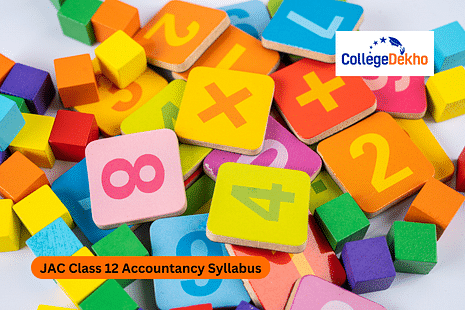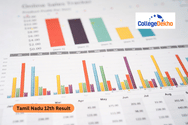- JAC Class 12 Accountancy Syllabus 2025-26 Download PDF
- JAC Class 12 Accountancy Syllabus 2025-26: Course Structure
- JAC Class 12 Accountancy Syllabus 2025-26: Unit-wise
- JAC Class 12 Accountancy Syllabus 2025-26 for Practical/ Project Work
- JAC Class 12 Accountancy Question Paper Design 2025-26
- JAC Class 12 Accountancy Books 2026
- Faqs


Never Miss an Exam Update
JAC Class 12 Accountancy Syllabus 2025-26 has two main parts, Part A: Accounting for Partnership Firms and Companies and Part B: Financial Statement Analysis. Part A will have topics from Accounting For Partnership Firms and Companies followed by the second section of Financial Statement Analysis. Part A is structured for 60 marks, Part B is for 20 marks, and project work is also for 20 marks. The Jharkhand Board follows a structure similar to the CBSE curriculum. The JAC 12th Accountancy theory paper will include multiple-choice questions (MCQs), short-type, long-type, and very long-type questions. After completing the syllabus, students can refer to the JAC Class 12 Accountancy Sample Paper 2026 uploaded on the official website for effective revision.
The Accountancy theory paper will be conducted for 80 marks and 20 marks will be allotted for the project work assigned to the students by their teachers. Check more information about the JAC Class 12 Accountancy Syllabus 2025-26 along with the direct PDF and the procedure to download the PDF from the official website here.
JAC Class 12 Accountancy Syllabus 2025-26 Download PDF
Students can check the direct PDF link to download the syllabus from the table given below and refer to it when preparing for the board exams:
JAC Class 12 Accountancy Syllabus 2025-26: Course Structure
The Accountancy syllabus is divided into two parts. Part A will consist of accounting for partnerships and companies and part B will consist of financial statement analysis. You can check out the detailed information about the Jharkhand Class 12th Accountancy Syllabus 2025-26 from the table given below:
| Units | Periods | Marks | |
|---|---|---|---|
| Part A | Accounting for Partnership Firms and Companies | ||
| — | Unit 1. Accounting for Partnership Firms | 105 | 36 |
| — | Unit 2. Accounting for Companies | 45 | 24 |
| — | — | 150 | 60 |
| Part B | Financial Statement Analysis | ||
| — | Unit 3. Analysis of Financial Statements | 30 | 12 |
| — | Unit 4. Cash Flow Statement | 20 | 8 |
| — | — | 50 | 20 |
| Part C | Project Work | 20 | 20 |
| — | Project work will include: | — | — |
| — | Project File | 12 Marks | — |
| — | Viva Voce | 8 Marks | — |
| — | Or | — | — |
| Part B | Computerized Accounting | ||
| — | Unit 4. Computerized Accounting | 50 | 20 |
| Part C | Practical Work | 20 | 20 |
| — | Practical work will include: | — | — |
| — | Practical File | 12 Marks | — |
| — | Viva Voce | 8 Marks | — |
JAC Class 12 Accountancy Syllabus 2025-26: Unit-wise
Students can refer to the chapters included in each unit of the syllabus from the table given below and prepare for the exam accordingly:
Name of Chapter | Subtopic of Chapter |
|---|---|
Chapter 1: Accounting for Partnership: Basic Concepts | 1.1 Nature of Partnership 1.2 Partnership Deed 1.3 Special Aspects of Partnership Accounts 1.4 Maintenance of Capital Accounts of Partners 1.5 Distribution of Profit among Partners 1.6 Guarantee of Profit to a Partner 1.7 Past Adjustments 1.8 Final Accounts |
Chapter 2: Reconstitution of a Partnership Firm – Admission of a Partner | 2.1 Modes of Reconstitution of a Partnership Firm 2.2 Admission of a New Partner 2.3 New Profit Sharing Ratio 2.4 Sacrificing Ratio 2.5 Goodwill 2.6 Adjustment for Accumulated Profits and Losses 2.7 Revaluation of Assets and Reassessment of Liabilities 2.8 Adjustment of Capitals 2.9 Change in Profit Sharing Ratio among the Existing Partners |
Chapter 3: Reconstitution of a Partnership Firm – Retirement/Death of a Partner | 3.1 Ascertaining the Amount Due to Retiring/Deceased Partner 3.2 New Profit Sharing Ratio 3.3 Gaining Ratio 3.4 Treatment of Goodwill 3.5 Adjustment for Revaluation of Assets and Liabilities 3.6 Adjustment of Accumulated Profits and Losses 3.7 Disposal of Amount Due to Retiring Partner 3.8 Adjustment of Partners’ Capitals 3.9 Death of a Partner |
Chapter 4: Dissolution of Partnership Firm | 4.1 Dissolution of Partnership 4.2 Dissolution of a Firm 4.3 Settlement of Accounts 4.4 Accounting Treatment |
Part B: Chapter 1: Accounting for Share Capital | 1.1 Features of a Company 1.2 Kinds of Companies 1.3 Share Capital of a Company 1.4 Nature and Classes of Shares 1.5 Issue of Shares 1.6 Accounting Treatment 1.7 Forfeiture of Shares |
Chapter 2: Issue and Redemption of Debentures | 2.1 Meaning of Debentures 2.2 Distinction between Shares and Debentures 2.3 Types of Debentures 2.4 Issue of Debentures 2.5 Over Subscription 2.6 Issue of Debentures for Consideration other than Cash 2.7 Issue of Debentures as a Collateral Security 2.8 Terms of Issue of Debentures 2.9 Interest on Debentures 2.10 Writing off Discount/Loss on Issue of Debentures 2.11 Redemption of Debentures 2.12 Redemption by Payment in Lump Sum 2.13 Redemption by Purchase in Open Market 2.14 Redemption by Conversion |
Chapter 3: Financial Statements of a Company | 3.1 Meaning of Financial Statements 3.2 Nature of Financial Statements 3.3 Objectives of Financial Statements 3.4 Types of Financial Statements 3.5 Uses and Importance of Financial Statements 3.6 Limitations of Financial Statements |
Chapter 4: Analysis of Financial Statements | 4.1 Meaning of Analysis of Financial Statements 4.2 Significance of Analysis of Financial Statements 4.3 Objectives of Analysis of Financial Statements 4.4 Tools of Analysis of Financial Statements 4.5 Comparative Statements 4.6 Common Size Statement 4.7 Limitations of Financial Analysis |
Chapter 5: Accounting Ratios | 5.1 Meaning of Accounting Ratios 5.2 Objectives of Ratio Analysis 5.3 Advantages of Ratio Analysis 5.4 Limitations of Ratio Analysis 5.5 Types of Ratios 5.6 Liquidity Ratios 5.7 Solvency Ratios 5.8 Activity (or Turnover) Ratio 5.9 Profitability Ratios |
Chapter 6: Cash Flow Statement | 6.1 Objectives of Cash Flow Statement 6.2 Benefits of Cash Flow Statement 6.3 Cash and Cash Equivalents 6.4 Cash Flows 6.5 Classification of Activities for the Preparation of Cash Flow Statement 6.7 Ascertainment of Cash Flow from Investing and Financing Activities 6.8 Preparation of Cash Flow Statement |
JAC Class 12 Accountancy Syllabus 2025-26 for Practical/ Project Work
One specific project based on financial statement analysis of a company covering any two aspects from the following:
1. Comparative and common size financial statements
2. Accounting Ratios
3. Segment Reports
4. Cash Flow Statements
OR
Part B: Computerised Accounting
Unit 4: Computerised Accounting
Overview of Computerised Accounting System
- Introduction: Application in Accounting.
- Features of Computerised Accounting System.
- Structure of CAS.
- Software Packages: Generic; Specific; Tailored.
Accounting Application of Electronic Spreadsheet.
- Concept of electronic spreadsheet.
- Features offered by electronic spreadsheet.
- Application in generating accounting information - bank reconciliation statement; asset accounting;
- loan repayment of loan schedule, ratio analysis
- Data representation- graphs, charts and diagrams.
Using Computerized Accounting System.
- Steps in installation of CAS, codification and Hierarchy of account heads, creation of accounts.
- Data: Entry, validation and verification.
- Adjusting entries, preparation of balance sheet, profit and loss account with closing entries and opening entries.
- Need and security features of the system.
Part C: Practical Work
JAC Class 12 Accountancy Question Paper Design 2025-26
Students must have detailed information about the structure that will be followed by the Jharkhand Academic Council to frame the question paper for accountancy. Refer to the information about the same from the table given below:
- Candidates should answer in their own words as much as possible.
- All questions are compulsory.
- Total number of questions is 52.
- Questions No. 01 to 30 are multiple-choice questions, each question has four options. Select the correct option. Each question carries a 01 mark.
- Question numbers 31 to 38 are very short answer questions. Out of which it is mandatory to answer any 6 questions. Each question carries 02 marks.
- Question numbers 39 to 46 are short answer questions. Out of which it is mandatory to answer any 6 questions. Each question carries 03 marks.
- Question numbers 47 to 52 are long answer questions. It is mandatory to answer any 4 questions. Each question carries 05 marks.
- Internal choices will be included in certain sections of the question paper.
JAC Class 12 Accountancy Books 2026
There are a bunch of books that should be considered by the students when preparing for the exam such as:
- Arihant All In One Class 12th Accountancy For Cbse Exam 2025
- All In One Accountancy Class 12th Based On Latest NCERT For CBSE Exams 2025
- CBSE 10 Previous Years Solved Papers Class 12 Commerce
- MTG CBSE 10 Years (2024-2015) Chapterwise Topicwise Solved Papers
- NCERT Textbook Of ACCOUNTANCY Part 1 and 2 For CLASS 12th
- Ts Grewal Class 12 Accountancy 2025-26 ( Combo of 3 Books)
- APC D K Goel Class12th Accountancy Part A + Part B (Combo) Latest Edition 2025
- SURA`S 12th Standard Accountancy Guide in English Medium 2025
- Arihant NCERT Solutions Accountancy for Class 12th
- CBSE Question Bank Class 12 Accountancy, Chapterwise and Topicwise Solved Papers
Students must refer to the latest JAC Class 12 Accountancy Syllabus 2025-26 to prepare well for the exam. The syllabus includes important information about the units and the chapters covered in the curriculum. Make sure to study every chapter in detail to get good marks in the results.
Are you feeling lost and unsure about what career path to take after completing 12th standard?
Say goodbye to confusion and hello to a bright future!

FAQs
To download the latest JAC Class 12 Accountancy Syllabus 2025-26, students need to first visit the official website of the Jharkhand Academic Council at jac.jharkhand.gov.in. The home page will open on your screen. You have to now click on the “Others” option present on the menu bar and then click on the option called Syllabus. The syllabus PDFs for the different classes will open on your screen.
As per the JAC Class 12 Accountancy Syllabus 2025-26, the following chapters are included in the curriculum: Accounting for Partnership: Basic Concepts, Reconstitution of a Partnership Firm – Admission of a Partner, Reconstitution of a Partnership Firm – Retirement/Death of a Partner, Dissolution of Partnership Firm, Accounting for Share Capital, Issue and Redemption of Debentures, Financial Statements of a Company, Analysis of Financial Statements, Accounting Ratios, and Cash Flow Statement.
To revise the JAC Class 12 Accountancy Syllabus 2025-26, students must focus on completing the model test papers as soon as they are done with their syllabus so that they can revise the things that they have learned. Make sure to also download the previous year's question papers uploaded on the official website to get hold of the commonly asked questions.
Completing the JAC Class 12 Accountancy Syllabus 2025-26 on time can be a challenging task, but it is achievable with the right approach and dedication. Students must first break down the syllabus into smaller sections and create a study schedule accordingly. Create a quiet and conducive study environment where you can focus on learning. Keep reminding yourself of your goals and stay motivated throughout the journey.
The official JAC Class 12 Accountancy Syllabus 2025-26 PDF is available on the website of the Jharkhand Academic Council to be downloaded by the students.
Was this article helpful?

















